50 Years of Who: Mrs Sexy, Gadgets, Gizmos & Theme
John Hussey continues his 50th anniversary retrospective, this time looking at the other elements that help make the show.
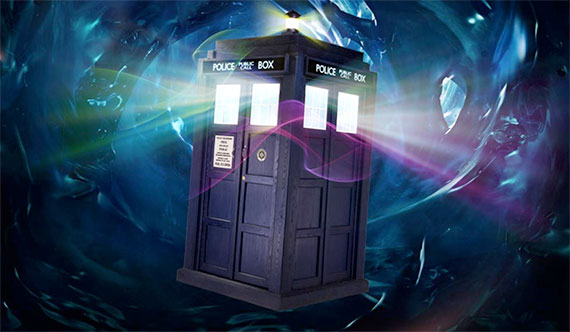
2013 is a milestone year for all things Whovian as Doctor Who reaches its 50th Anniversary, marking 50 years since the show first materialised on our screens back in 1963. Along with my 50th Anniversary Retrospective
The Function
 Starting off with the TARDIS, the function of the Doctor’s mad blue box is to allow our beloved hero and his many companions to actually journey on their adventures in the first place. It is the key to the Doctor’s life and purpose. She allows him to fulfil his destiny. This started from the moment they met back on Gallifrey; both of whom wanted a better life outside of the Citadels walls. The mad blue box is almost like the blueprint, and also in a sense, the heart of the show along with the Doctor. They both bring a huge significance to Doctor Who through the different meanings and through these meanings complement each other which allow the stories we see to be told. They require each other to do their part and one without the other would basically mean the end of the show as we know it. The Doctor is the hero who gallivants across space and time, journeying the universe for adventures and to fight evil wherever he should face it while the TARDIS is the very being who grants the Doctor those wishes and takes him there. She is the magical doorway which grants us passage to all of the wonders and unknown throughout time and space. Also the TARDIS is the pull factor of Doctor Who, the hook in other words, who helps to bring in us the viewer into the Doctor’s universe along with the Time Lord himself. Everytime a new companion comes along they have to make their first step onboard the TARDIS which allows them and us at the same time to delve into the Doctor’s world and home. This is his life and the TARDIS allows us to share in that life and all of his wonders.
Starting off with the TARDIS, the function of the Doctor’s mad blue box is to allow our beloved hero and his many companions to actually journey on their adventures in the first place. It is the key to the Doctor’s life and purpose. She allows him to fulfil his destiny. This started from the moment they met back on Gallifrey; both of whom wanted a better life outside of the Citadels walls. The mad blue box is almost like the blueprint, and also in a sense, the heart of the show along with the Doctor. They both bring a huge significance to Doctor Who through the different meanings and through these meanings complement each other which allow the stories we see to be told. They require each other to do their part and one without the other would basically mean the end of the show as we know it. The Doctor is the hero who gallivants across space and time, journeying the universe for adventures and to fight evil wherever he should face it while the TARDIS is the very being who grants the Doctor those wishes and takes him there. She is the magical doorway which grants us passage to all of the wonders and unknown throughout time and space. Also the TARDIS is the pull factor of Doctor Who, the hook in other words, who helps to bring in us the viewer into the Doctor’s universe along with the Time Lord himself. Everytime a new companion comes along they have to make their first step onboard the TARDIS which allows them and us at the same time to delve into the Doctor’s world and home. This is his life and the TARDIS allows us to share in that life and all of his wonders.
Moving on to the many different gadgets and gizmos, the Doctor has used throughout his travels, their function is another straight forward thing; they are there to aid him on his journey’s. They are there to help the Time Lord get out of trouble; a prime example of this would be his trusty friend the Sonic Screwdriver which was first used within ‘Fury from the Deep’. Another function is to perhaps help him to learn about the situation that he has been placed within. The final usage would be for transport as seen with the Doctor’s trusty vehicles Bessie (first seen in ‘Doctor Who and the Silurians’) and the Whomobile (first seen in ‘Invasion of the Dinosaurs’).
Lastly, the legendary theme music, first composed by Ron Grainer back in the 60s, forms the function of being a symbol for Doctor Who. The music is very much the signifier of the show and upon hearing its tune, people instantly recognise it and relate it back to Doctor Who. Also it acts as a hook to draw in us the viewers to sit and watch the show. As soon as its tune kicks in, we instantly shut everything else out and concentrate upon the opening credits and the adventures that will follow. The theme is mesmerising in many ways and it has survived throughout the show’s history through its different composers and styles/variations. It also hooks us in to prepare for the next episode after a cliff-hanger as soon as it kicks in to signify that the end of the current episode has come and will be continued the following week. The music the theme produces has a powerful affect and I believe it is one of the sole reasons the show has survived and remained so iconic.
The TARDIS consoles
There have been many different types of styles Mrs. Sexy has taken over the course of the legacy of the show. Each one of them takes on their own kind of form and represents the current nature and tone of the show as well as that of the Doctor’s.
The Original Console Room (used by The First, Second, Third, Fourth and Fifth Doctor)
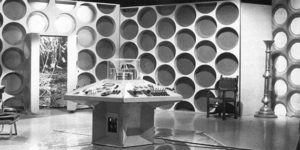 The Original Console Room was first seen in ‘An Unearthly Child’ after Ian Chesterton and Barbara Wright stumbled upon its secret in Totters Lane. The original control room for the TARDIS was a plain white and retained its traits of having circular patterns around the room with a scanner on the wall and the console in the centre with its iconic rotor. Originally it contained a mass amount of different equipment and furniture, with the prime example being the Fault Detector which was heavily seen in ‘The Daleks’ and ‘The Edge of Destruction’. As time went by, along with the different incarnations, the Original Console Room contained less and less and became more basic in design, containing the relevant things the Time Lord required. It appeared to be very alien and had a machine feeling to it that represented the early years of the Doctor’s life. The Original Console Room made its last appearance in ‘The King’s Demon’.
The Original Console Room was first seen in ‘An Unearthly Child’ after Ian Chesterton and Barbara Wright stumbled upon its secret in Totters Lane. The original control room for the TARDIS was a plain white and retained its traits of having circular patterns around the room with a scanner on the wall and the console in the centre with its iconic rotor. Originally it contained a mass amount of different equipment and furniture, with the prime example being the Fault Detector which was heavily seen in ‘The Daleks’ and ‘The Edge of Destruction’. As time went by, along with the different incarnations, the Original Console Room contained less and less and became more basic in design, containing the relevant things the Time Lord required. It appeared to be very alien and had a machine feeling to it that represented the early years of the Doctor’s life. The Original Console Room made its last appearance in ‘The King’s Demon’.
The Second Console Room (used by The Fourth Doctor)
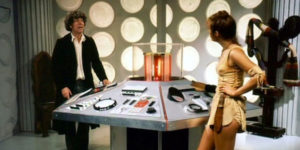 The second was first seen in ‘The Masque of Mandragora’ after the Fourth Doctor and Sarah Jane Smith stumbled upon it during a walk through the TARDIS’s corridors. The Fourth Doctor identified it as the Second Control Room and decided to use it as the main room for a short period of time. The room was darker than the original console room and the walls were made up of wooden panels like an old Victorian style building. The console itself was also different. It had no rotor and had the appearance of a study desk which contained secret compartments which contained the different switches to control the ship. The Second Control Room made its last appearance in ‘The Robots of Death’.
The second was first seen in ‘The Masque of Mandragora’ after the Fourth Doctor and Sarah Jane Smith stumbled upon it during a walk through the TARDIS’s corridors. The Fourth Doctor identified it as the Second Control Room and decided to use it as the main room for a short period of time. The room was darker than the original console room and the walls were made up of wooden panels like an old Victorian style building. The console itself was also different. It had no rotor and had the appearance of a study desk which contained secret compartments which contained the different switches to control the ship. The Second Control Room made its last appearance in ‘The Robots of Death’.
 The Rebuilt Console Room (used by The Fifth, Sixth and Seventh Doctor)
The Rebuilt Console Room (used by The Fifth, Sixth and Seventh Doctor)
The Rebuilt Console Room was first seen in ‘The Five Doctors’ after the Fifth Doctor decided to do some well overdue repairs and updated his beloved TARDIS; coaxing and persuading her as he states to Tegan Jovanka, referring to his space-time machine as a living being. This was the first major alteration to the console. It underwent a redesign that gave it a further hi-tech look to it and made it sleeker and more sophisticated. The rest of the room remained the same. This console room made its last appearance onscreen in ‘Battlefield’.
 The Victorian Parlour (used by The Seventh and Eighth Doctor)
The Victorian Parlour (used by The Seventh and Eighth Doctor)
The Victorian Parlour was first seen in ‘Doctor Who’ as the now established home for the Seventh Doctor (after many years had passed off-screen during Doctor Who’s cancellation) while he took the Master’s ashes back to Gallifrey as requested. After the Seventh Doctor regenerated, it became the Eighth Doctor’s TARDIS. The console Room became more vast and became a very dark and gothic environment riddled with relics that the Doctor had collected over the years. The room contained a library and even a small study which had a comfy chair and table for the Time Lord to sit at and read. The console itself was more steam-punk in design and the rotor went all the way up to the ceiling, a new feature not seen before in earlier designs. This console room was last seen in ‘Doctor Who’.
 Coral (Used by The Ninth and Tenth Doctor)
Coral (Used by The Ninth and Tenth Doctor)
The Coral Console Room was first seen in ‘Rose’ after it was introduced to Rose Tyler by the Ninth Doctor. It went for a more organic look and for the first time it was implied that the TARDIS was grown rather than built. Earlier designs made the ship to look more mechanic, whereas this design represented the more living embodiment that was hinted throughout the Doctor’s life and journeys with his faithful ship. Along with the more organic features, it appeared to be quite battered and broken; put together with random inanimate objects from Earth. The Tenth Doctor adopted this version of the console room after the Ninth Doctor regenerated. The Coral Console Room was last seen in ‘The End of Time’.
 Retro Console (Used by The Eleventh Doctor)
Retro Console (Used by The Eleventh Doctor)
The Retro Console was first seen in ‘The Eleventh Hour’ after the Eleventh Doctor unveiled it to Amy Pond. This version of the TARDIS came about after it regenerated itself due to the damages caused to it during the Tenth Doctor’s struggled regeneration. Like with the previous design, the TARDIS went for a further organic look and represented itself as a living entity. Also like with the previous design it retained its idea of being built together with random inanimate objects, though this time the console itself is fresh and shiny rather than being dark and battered. This console room went back to the idea of the Victorian Parlour of having a vast area. In this design we had different floors and stairs that led to different parts of the ship. The Retro Console Room was last seen in ‘The Angels Take Manhattan’.
 Neon Console
Neon Console
(Used by The Eleventh Doctor) The Neon Console was first seen in ‘The Snowmen’ after it was unveiled to Clara Oswin Oswald in Victorian England. This design kept the same idea of the previous one in having different layers and staircases but went against the organic look and idea of the previous two console rooms. The design reverted back to the more mechanical look of the earlier console rooms. This one is the most mechanic of them all with it having metal walls and panels surrounding the room along with its very dark metallic colouring scheme. The Neon Console room is currently ongoing and may well stay until after the Twelfth Doctor arrives at Christmas (we shall see).
The Gadgets & Gizmos
Here are a few examples of gadgets and gizmos the Doctor has used over the course of his adventures and their rightful function.

The Sonic Screwdriver has been the main gadget used by the Doctor throughout his adventures in time and space. The little device can be used for a huge range of activities, including its most popular function of opening doors. Over the years (especially within the revived series) its abilities and capabilities have grown and grown, making the device a trusty little gizmo for the Time Lord to use in order to get him out of situations. The only flaw within the device is its inability to unlock wooden doors which has caused the Doctor endless problems, especially when he came across aliens made of wood in ‘The Doctor, the Widow and the Wardrobe’.

Bessie was the trusted vehicle of the Third Doctor during his exile on Earth which was first introduced in ‘Doctor Who and the Silurians’. The vintage yellow car was constructed by the Doctor through his funds at U.N.I.T. and it accompanied him throughout his exile and right up to the Third Doctor’s regeneration in ‘Planet of the Spiders’. Bessie was used briefly by the Fourth Doctor but was forgotten about after the Time Lord decided to return to the stars in his TARDIS, journeying through time and space once again after his lifted sentence. Bessie made a long awaited return in ‘The Five Doctors’, once again accompanied by the Third Doctor, and later on in ‘Battlefield’ where the Seventh Doctor used his trusty vehicle to help the Brigadier stop Morgaine. It certainly got the Doctor from A to B and even aided him in a chase or two. The Whomobile was the Third Doctor’s second vehicle, this time a more hi-tech car which served as a hovercraft on his missions for U.N.I.T.. The vehicle sadly only lasted for two adventures; ‘Invasion of the Dinosaurs’ and ‘Planet of the Spiders’.
Visualiser

HADS
(Hostile Action Displacement System) The Hostile Action Displacement System was a handy little gadget that made the TARDIS teleport to safety if under attack by a hostile force. It was first introduced in ‘The Krotons’ where the Krotons attempted to vaporise the space-time ship with their deadly weapons but dematerialised itself using HADS to a different location. This was its only appearance onscreen up until it made a return many years later in ‘Cold War’ when the TARDIS teleported to the South Pole in order to escape a sinking submarine.
De-Mat Gun

Randomiser
The Randomiser was a clever little device used to control the TARDIS to materialise at random across time and space in order to allow the Fourth Doctor and Romana to hide from the wrath of the Black Guardian after his defeat in ‘The Armageddon Factor’. The device was used for a total of one season (Season 17) until the Fourth Doctor removed the device at the beginning of Season 18, ‘The Leisure Hive’, in favour of returning to normal travels having gotten bored of being told where to land. Nitro-9 Nitro-9 was an explosive formula created by Ace and was used on many occasions during the Seventh Doctor’s adventures to get them out of trouble, even at one point being used to destroy both a Dalek and a Cyberman spacecraft. Though Nitro-9 proved to be a handy gadget, the Seventh Doctor still disapproved of its usage and often told Ace off for either using too much or miscalculating the timer.
Nanorecorder
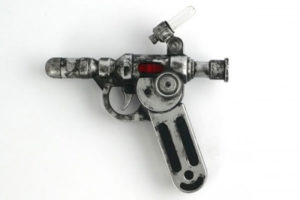
The Main Theme
The theme has taken on many shapes over the 50 years of Doctor Who but the fundamental beat and melody has remained the same. Here the different versions of the theme up until present day.
The First Doctor’s Theme
The original theme was quite basic and very eerie to say the least. It was riddled in mystic and mystery, really giving the 60s episodes a real kick in order to attract attention from the audience. The beat and melody was unique for its time and certainly stuck in the minds of millions of people.
The Second Doctor’s Theme
The first adaptation of the original Theme became more upbeat and adventurous while still keeping the mystic that the original entailed. It also got the added feature of electronic sounds added to the mix, allowing it to progress into the second era of the show.
The Third and Fourth Doctor’s Theme
The second and third adaptation didn’t alter too much from the Troughton introduction but certainly took the electronic addition further and gave it a 70s feel to it. The theme certainly started to become more epic and more iconic.
The Fifth Doctor’s Theme
The fourth adaptation certainly took a major step forward in developing the theme as it took it on a more science-fiction route by making the entire beat and melody electronic sounding. It gave it a very 80s style tone and tune and it helped to shape the new era that was born within the 80s era of the show.
The Sixth Doctor’s Themes
The fifth adaptation was very much the same as the Davison introduction only given a deeper sound to it. The sixth adaptation was the first major change since the fifth adaptation came along. It went for a more darker feel and tried to make the show sounds series and more mysterious again, like with the original Theme. Like with the original, it sounded very eerie.
The Seventh Doctor’s Theme
The seventh adaptation went again with the whole electronic feel and went back to making the show sound adventures giving the beat and melody a very heroic feel to it for the last few years of the Classic Series.
The Eighth Doctor’s Themes
The eighth adaptation went for a very epic feel along with the continuous adventure nature kicking in too. It felt grand and movie scaled in some respects and really opened up a new (but short) era to the show. The Big Finish Audio Adventure adaptation of the theme for the Eighth Doctor adventures went back to the more darker and serious roots and created an eerie Theme that accompanied this incarnations stories.
The Ninth Doctor Theme
The ninth adaptation kicked off the orchestra reign of the theme. This adaptation was very similar to the 70s version of the theme with the added kick of more adventure along with a sense of a rocky age to it.
The Tenth Doctor’s Themes
The tenth adaptation went with a very rock centred style with electric guitars being the centre of the beat and melody along with a great sense of orchestra than the last version. This created a very epic and deep adventurous tone to accompany the Tenth Doctor’s final few years on the show.
The Eleventh Doctor’s Themes
The eleventh adaptation went for a slower and darker nature with orchestra still being at the centre. It went with a more echo sound-effects along with the usage of thunderbolts to get across the new tone of the show. The twelfth and final adaptation continued the style of the previous Theme but gave it a more deeper and bass filled sound, making it seem even more darker but with the addition of a more adventurous tone once again.
The theme has accompanied the show since its very beginning and has helped to shape and change the show’s tone and appearance throughout it all. It is a testament to Ron Grainer and the Radiophonic Workshop for its creation and of course all the wonderful composers who have come and gone afterwards to help progress and adapt that same tune over and over again in order to keep it fresh and alive to this very day.
Why all these elements have kept the show going

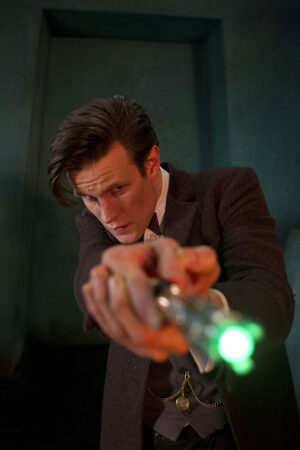
At one point the Sonic Screwdriver was discarded after it was destroyed in ‘The Visitation’ by the Terileptil. The Doctor for a long time went without using the device, although the Fifth Doctor admitted upon its destruction that he felt he’d lost an old friend. Like the TARDIS the Sonic Screwdriver became sentimental and a part of the Doctor’s life and in a way his family. In ‘Snakedance’ Nyssa commented on the fact that the Fifth Doctor should’ve replaced the Sonic Screwdriver. It finally made its return in ‘Doctor Who’ where the Seventh Doctor now had one in his possession. Upon Doctor Who’s return in ‘Rose’ the Ninth Doctor also had a newly built Sonic Screwdriver and the Time Lord has kept his trusty device ever since. The device had another major revamp in ‘The Eleventh Hour’ after the Ninth/Tenth Doctor design was also destroyed and in its place came a new one to represent the characteristics of the current incarnation of the Doctor. The Sonic Screwdriver in many ways represents the mad and bonkers ideas that the Doctor has and it reflexes within his little invention which he has carried around with him all these years on and off.
The other famous ‘gadget’ is obviously the Doctor’s trusted vehicle Bessie who accompanied the Third Doctor during his exile on Earth. It represented that incarnations James Bond style attitude; always wanting gadgets and fast vehicles to help him save the day. Bessie stayed on with the Fourth Doctor briefly before making its last return in ‘Battlefield’ with the Seventh Doctor.
The theme has helped to keep the show alive due to its iconic music and melody. It is one of the most memorable pieces of music on the entire planet. It’s simply iconic. The strange and mystical beats have remained a part of the show’s mythology and Britain’s history for 50 years and still remains strong and within the hearts of many. It has opened and closed the Doctor’s adventures since the very beginning of the show back in 1963. The music represents the show. It’s riddled in mystic. It’s in the title. Doctor Who – who is the Doctor? The music releases an eerie melody that delivers the tone of the show and the character of the Time Lord we have followed for the last 50 years. The unique thing about the theme is it has remained exactly the same (give or take) throughout the show’s entire reign on television. Sure it’s had many revamps or different variations through its different composers over the many eras of the show but the fundamental melody and tune has remained intact and to this day remains alive and kicking. It has helped to make Doctor Who recognisable and in itself has become a unique piece of music that people across the planet instantly recognise and associate with the show.
Best stories making use of these elements
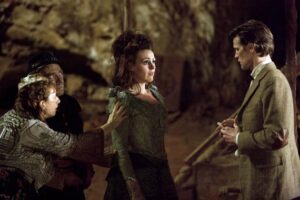
– The TARDIS
The first story the TARDIS appeared in really made a statement and like Susan Foreman’s role of hooking us in, the space-time ship did exactly the same and opened us up to the mad and wonderful world that the Time Lord lives within. ‘The Doctor’s Wife’ was an interesting piece that really did some character building on the Doctor’s trusted ship and allowed her for the first time to speak and really express herself. It really was a touching story that allowed us to delve deeper into the living space-vehicle that allows us and the Doctor to journey on the many adventures seen onscreen. The final choice was another example of delving deeper into the TARDIS’s character but this time from a more visual perspective rather than physical as done with ‘The Doctor’s Wife’. We got to see more of the inner workings of the ship while constantly being reminded that she is a living being and she and the Doctor have a long history of friendship under their belts.
‘The Daemons’, ‘The Big Bang’ and ‘Day of the Moon’
– Gadgets and Gizmos
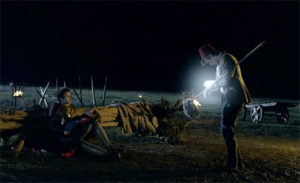
With the theme I can’t exactly say what my favourite story is for them for obvious reasons. But for this one particular subject I will do something different by choosing my favourite theme instead (which you can join in with within the comment section below) and discuss why I have chosen them within my top five favourites.
5. The Eighth Doctor’s Theme
By Big Finish
This is an interesting pick as I’ve only recently hear the theme for the Eighth Doctor’s Audio Adventures for Big Finish (plus a lot of you won’t have come across it due to never listening to a Big Finish adventure). It is a more darker composing of the original theme that really does reflect the wilderness adventures of the Eighth Doctor’s tenure.
4. The Eleventh Doctor’s Theme (2nd) (2012-13)
Composed by Murray Gold
The current Theme is an interesting one as it really reflects visually the history of the show by having all the different Opening Sequences merged into one show and tell for the 50th year. Plus the theme itself is a nice little update of Eleven’s previous Theme that ran from ‘The Eleventh Hour’ to ‘The Angels Take Manhattan’.
3. The Seventh Doctor’s Theme (1987-89)
Composed by Keff McCulloch
This 80s some of the most interesting experimentations with the Theme of the show and this one was the most successful out of them I think. It certainly sounded different, while remaining true to the original version, and exploded with the sound of adventure and a new age. Plus its music always touched my heart somehow with its beautiful melody.
2. The Fourth and Fifth Doctor’s Theme (1980-84)
Composed by Peter Howell
Although I said the above choose was the most successful out of the 80s Themes, I do believe this one was the most iconic and memorable. It had a cracking tune that you wanted to stick with right until the thunderous end as the sonic boom erupted.
1. The Third and Fourth Doctor’s Theme (1970-80)
Composed by Delia Derbyshire
This one will always be my favourite adaptation of the Theme of the show. It was just a brilliant piece of music which I love to listen to when I watch the eras it’s played within. Not only is the music good but it also reflects two of my favourite Doctor’s and their respective eras and I the music does them justice.
Next Time…
The fourth and final part to 50 Years of Who will look over the Time Lord himself. I will talk about the mad man with a box and I will discuss why he, like both the Companions, the Monsters and Villains, Mrs Sexy, the Gizmos & Gadgets and the Theme, have helped shape and keep Doctor Who alive for its 50 years of legacy.








